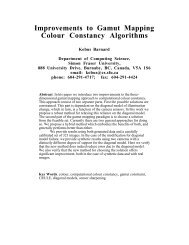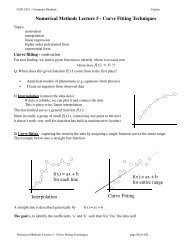1 Introduction
1 Introduction
1 Introduction
- No tags were found...
Create successful ePaper yourself
Turn your PDF publications into a flip-book with our unique Google optimized e-Paper software.
1.5. Decision Theory 43subsequent decision stage in which we use these posterior probabilities to make optimalclass assignments. An alternative possibility would be to solve both problemstogether and simply learn a function that maps inputs x directly into decisions. Sucha function is called a discriminant function.In fact, we can identify three distinct approaches to solving decision problems,all of which have been used in practical applications. These are given, in decreasingorder of complexity, by:(a) First solve the inference problem of determining the class-conditional densitiesp(x|C k ) for each class C k individually. Also separately infer the prior classprobabilities p(C k ). Then use Bayes’ theorem in the formp(C k |x) = p(x|C k)p(C k )p(x)(1.82)to find the posterior class probabilities p(C k |x). As usual, the denominatorin Bayes’ theorem can be found in terms of the quantities appearing in thenumerator, because∑ p(x) = p(x|C k )p(C k ). (1.83)kEquivalently, we can model the joint distribution p(x, C k ) directly and thennormalize to obtain the posterior probabilities. Having found the posteriorprobabilities, we use decision theory to determine class membership for eachnew input x. Approaches that explicitly or implicitly model the distribution ofinputs as well as outputs are known as generative models, because by samplingfrom them it is possible to generate synthetic data points in the input space.(b) First solve the inference problem of determining the posterior class probabilitiesp(C k |x), and then subsequently use decision theory to assign each new x toone of the classes. Approaches that model the posterior probabilities directlyare called discriminative models.(c) Find a function f(x), called a discriminant function, which maps each input xdirectly onto a class label. For instance, in the case of two-class problems,f(·) might be binary valued and such that f =0represents class C 1 and f =1represents class C 2 . In this case, probabilities play no role.Let us consider the relative merits of these three alternatives. Approach (a) is themost demanding because it involves finding the joint distribution over both x andC k . For many applications, x will have high dimensionality, and consequently wemay need a large training set in order to be able to determine the class-conditionaldensities to reasonable accuracy. Note that the class priors p(C k ) can often be estimatedsimply from the fractions of the training set data points in each of the classes.One advantage of approach (a), however, is that it also allows the marginal densityof data p(x) to be determined from (1.83). This can be useful for detecting new datapoints that have low probability under the model and for which the predictions may





